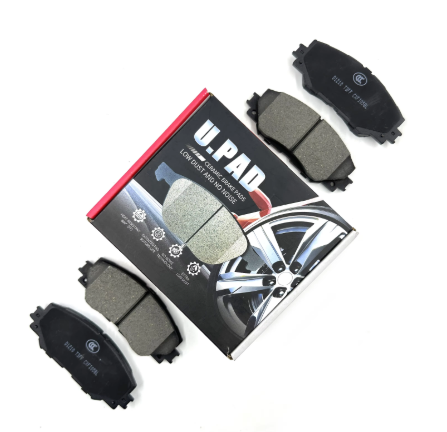The Essential Role of Brake Pads in Your Vehicle
What Are Brake Pads?
The brake pads form an essential part of any car's disc brake setup, basically made up of some friction material attached to a metal backing plate. When pressed against the rotors, these pads create the necessary friction to either slow down or bring the vehicle to a complete stop. There are actually several different kinds of brake pads available on the market today, tailored for various road situations and vehicle makes. Ceramic options tend to be really quiet and last longer than most alternatives, while semi-metallic ones handle heat better and stand up to wear and tear, which is why many sports cars go for this type. Getting familiar with what brake pads do matters quite a bit since their condition directly affects both safety behind the wheel and how well the whole braking system performs overall.
The Science of Friction and Stopping Power
Friction basically works against movement when two solid things touch each other, which makes it really important for how brakes function properly. What stops a car isn't just about pressing down hard on the pedal though. The actual stopping power comes mostly from those brake pads sitting under the hood. Research indicates that old or damaged brake pads will actually make cars take longer to stop completely, something nobody wants while driving down a busy street. Keeping friction levels right matters because these pads turn moving energy into heat during braking. Most mechanics recommend checking brake pads every so often to keep them working well. This simple maintenance helps maintain better stopping ability and cuts down accident chances significantly over time.
Breaking Down the Braking Process
How Brake Pads Interact with Rotors
Stepping on the brake pedal sets off a chain reaction inside the braking system. The hydraulic pressure forces calipers to squeeze those brake pads right onto the spinning rotors, creating enough friction to bring the car to a stop. What makes this work so well? Simple physics at play here – all that movement gets turned into heat through friction, which slows those wheels down. Brake pads matter a lot in all this. Old or cheap pads just don't cut it anymore. They wear down over time and lose grip, making stops longer than they should be. That's why regular checks are important for anyone who wants to stay safe behind the wheel.
Hydraulic Pressure and Caliper Action
Vehicle brakes work like magic really, using fluid pressure to multiply what the driver actually pushes down on the brake pedal. The calipers need this extra power since they hold those brake pads and squeeze them onto the spinning rotors whenever we hit the brakes. Knowing how all this works helps spot problems before they become big trouble. Take a look at what happens when something goes wrong. If the brake fluid leaks out somewhere or the caliper gets stuck, then those pads just don't press hard enough against the rotor. That means longer stopping distances and yes, higher chances of getting into a collision.
Energy Conversion: From Motion to Heat
When brakes work, they actually convert the energy of moving cars into heat through friction. A lot of this heat builds up fast during hard stops or downhill driving. Brake pads and rotors need to get rid of this heat quickly so everything keeps working properly. If the system gets too hot, something called brake fade happens where the brakes just don't grab as well anymore. That means longer stopping distances and serious safety risks on the road. Good heat management makes all the difference for reliable braking, especially when conditions change suddenly like in wet weather or mountainous areas where drivers need maximum stopping power without fail.
Types of Brake Pads Explained Simply
Organic Brake Pads: Quiet and Affordable
Organic brake pads mix different materials like fibers and rubber together, which is why they run so quietly during normal city driving. They're pretty budget friendly too, making them a go to choice for folks who don't put many miles on their cars each week. The downside? These pads don't last long when someone regularly drives aggressively or hauls heavy loads because the material just isn't that tough. Still worth considering though for smaller cars where noise reduction matters more than extreme durability, especially around town where most drivers spend 90% of their time anyway.
Ceramic Brake Pads: Premium Performance
Ceramic brake pads are made from dense ceramic material and generally last longer than other types. They create way less dust around the wheels and don't make as much noise during normal driving, which is why many people go for them if they want a quieter car experience. Sure, these pads come with a bigger price sticker upfront compared to standard options, but most mechanics will tell you they hold up better long term so the extra money often pays off in the end. Car manufacturers tend to install ceramic brakes on sports cars and luxury models where stopping power matters most, and drivers notice the difference in how smoothly the car stops without wearing down the rotors so fast.
Semi-Metallic Brake Pads: Heavy-Duty Solution
Semi metallic brake pads are basically made from metal fibers held together with some kind of resin material. They last longer than most other types and get rid of heat pretty well too. Truck owners and people who drive sports cars often go for these because they can take a lot of punishment. Sure, they tend to make more noise when stopping compared to ceramic pads, but nobody really cares about that when driving through mountain passes at night where temperatures drop below freezing. For serious off road adventures or hauling heavy loads across country, there just isn't anything else quite as reliable out there.
Recognizing When Brake Pads Need Attention
Common Signs of Brake Pad Wear
Knowing what to look for when brake pads start wearing out helps keep cars running safely without causing bigger problems later on. Most people notice their brakes making loud squeaks or screeches whenever they stop suddenly, something that usually means those pads have gotten pretty thin and should probably be replaced soon. Sometimes there will also be shaking felt through the brake pedal when pressed down hard, pointing toward possible issues with how evenly the pads are wearing away over time. And don't forget about that little warning light that sometimes pops up on dashboards either! Paying attention to all these signals makes driving much safer overall, not just for drivers but everyone else sharing the road too.
Understanding Brake Dust and Noise
When looking at brake systems, dust accumulation and noise levels tell quite a story about what's going on with those brake pads underneath. The stuff we call brake dust actually comes from normal wear during stops, but when it builds up too much, that usually means the pads have gotten pretty thin over time. Some kind of action might be needed soon if this happens regularly. Different types of brake material definitely create different sounds while stopping. Ceramic brakes tend to be quieter compared to organic ones which sometimes squeak more. Knowing what kind of noise is normal versus abnormal helps mechanics figure out what needs fixing before things get worse. Keeping an eye on these signs through regular inspections not only keeps dust from becoming a mess on wheels but also makes sure all those expensive parts last longer without sudden failures that nobody wants when pulling out of a parking lot.
The Importance of Regular Inspections
Checking the brakes on cars regularly helps stop big problems before they start happening. Most mechanics recommend getting the brakes looked at about once per year or after driving around 12 thousand miles, whichever happens sooner. When people keep up with this kind of maintenance, small issues get spotted and fixed before turning into expensive repairs. The car stays safer too during daily driving. People who make time for these checkups find their vehicles run better overall while saving money in the long run since worn out brake components last longer when maintained properly rather than ignored until failure occurs.
Maintaining Your Braking System
Best Practices for Brake Pad Longevity
Brake pads last longer when we stick to regular maintenance routines. Keeping those brake parts clean cuts down on wear and tear, so they don't need replacing as often. Drivers should watch how they handle their vehicles too because slamming on brakes all the time wears them out faster than gentle stopping does. Going for premium grade brake pads designed for actual road conditions makes a real difference over time. Smart decisions about maintenance and product selection keep the whole braking system working properly for years without breaking down unexpectedly.
When to Replace Brake Rotors
The brake rotors are really important for keeping any car's brakes working properly and safely. Most mechanics will tell drivers to get new rotors installed once they go beyond what the car maker says is acceptable wear. When looking at the rotor surfaces, things like deep grooves or noticeable warping usually mean the rotors aren't doing their job right anymore and need replacing soon. Regular maintenance shouldn't just check those brake pads everyone talks about all the time. A good mechanic always looks at the condition of the rotors too because this affects how well everything works together in the braking system. Taking care of both parts ensures better stopping power and keeps everyone safer on the road.
Modern Innovations in Brake Technology
Keeping up with what's new in brake tech really makes a difference for both safety and how well cars perform. These days most vehicles come equipped with things like ABS brakes that help drivers stay in control when stopping suddenly. The system prevents wheels from locking up completely during emergency stops, something every driver hopes never happens but should prepare for. Brake manufacturers are also experimenting with different materials lately. Some companies have started using ceramic composites that last longer than traditional metal options while producing fewer emissions during production. For anyone shopping for a car or considering upgrades, understanding these trends helps pick out better braking solutions. Mechanics often recommend checking if newer models offer improved stopping power without sacrificing fuel efficiency.
FAQ Section
What type of brake pads should I choose for my vehicle?
The choice depends on your driving needs. Organic pads are quiet and affordable, ceramic pads offer premium performance with less dust, and semi-metallic pads are ideal for heavy-duty use.
How often should I inspect my brake pads?
It is recommended to inspect brake pads at least once a year or every 12,000 miles for optimal safety and performance.
How do I know when to replace my brake rotors?
Replace brake rotors when you notice wear signs such as grooves or warping, or when they exceed wear specifications.

